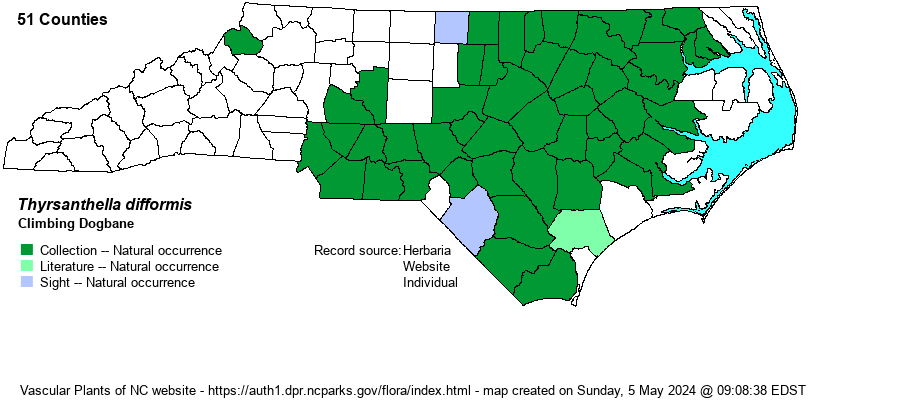| Author | (Walter) Pichon | |
| Distribution | Present over all of the Coastal Plain except close to the coast. Also present across the eastern half of the Piedmont, ranging west to Caswell, Rowan, and Mecklenburg counties. The specimen from Watauga County is probably misidentified, as there are no other specimen records for anywhere near that county.
This Southern species ranges from DE and southern MO south to central FL and eastern TX. It is essentially absent from the Appalachians and Cumberlands (mountain regions). | |
| Abundance | Common in the central and western Coastal Plain, and fairly common in the eastern Piedmont. Infrequent in the central Piedmont. Absent to very rare in the far eastern Coastal Plain, where there are no records east of Gates, Perquimans, Beaufort, and Craven counties. Why NatureServe has its Global Rank as G4G5, instead of an obvious G5, is puzzling. | |
| Habitat | This is a species primarily of damp soil, and is generally considered as a wetland plant. It favors openings and edges of bottomland forests and swamps, wet thickets, edges of rich forests, and less so along margins of mesic forests. It can occur in marshes, but it mainly prefers edges of wooded habitats. It normally is infrequent in deep shade of forest interiors. |
| Phenology | Blooms from May to July, and fruits from July to September. | |
| Identification | This is an herbaceous vine with highly variable leaf shapes! It can grow to as long as 10 feet to rarely 20 feet long and high, often growing well into lower limbs of trees and over taller shrubs. It has numerous paired (opposite) leaves, mostly sessile or with a very short petiole, but very variable even on the same plant. Some leaves are ovate-elliptic and about 2-3 inches long and about half as wide, but other pairs of leaves are narrowly elliptic to lanceolate and barely 1/2-inch wide. This leaf shape and width variation is helpful in separating vegetative plants from other species, especially from Japanese Honeysuckle (Lonicera japonica), which normally has leaves of the same width though some can be lobed. But, Climbing Dogbane has milky sap, and thus when you break a stem or a leaf at its base, and a white sap emerges, then it should be the dogbane. In bloom or fruit, this species is quite distinctive; it has several small clusters of a few flowers each from scattered nodes, each cluster on a slender stalk, and with somewhat tubular light greenish-yellow flowers with spreading petals. The fruits are typical for members of the Family Apocynaceae, being a long and extremely slender pod that grows to 5-6 inches long but just barely 1/10-inch wide. In summary, this is a familiar and reasonably easily found vine that climbs up onto shrubs or small trees at the edges of moist or damp forests and thickets, and should be identifiable by its variably-shaped leaves on a single plant and by its milky sap. | |
| Taxonomic Comments | This is another species that has been moved to a "new" genus in very recent times. It has or had long been named as Trachelospermum difforme, but Weakley (2018) and others have recently moved it to the genus Thyrsanthella, with a slight specific name change to difformis. Not that Thyrsanthella is easy to say, but it has "only" 13 letters and four syllables, as compared with 15 letters and five syllables in Trachelospermum!
| |
| Other Common Name(s) | None | |
| State Rank | S5 | |
| Global Rank | G4G5 [G5] | |
| State Status | | |
| US Status | | |
| USACE-agcp | FACW link |
| USACE-emp | FACW link |

